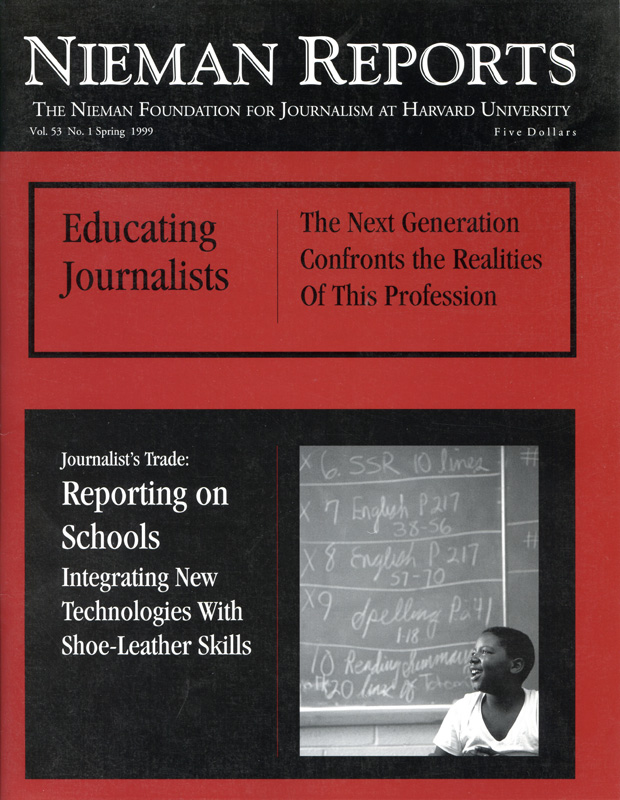Any reporter working in the twilight of the Cold War and into the 1990’s knows how much journalism has changed. The Cold War world was a more predictable place for foreign correspondents. We kept score on the ideological battles of the 20th Century. While some of the hot spots of that period threatened to spill over into conflicts that could have involved the superpowers, the risk of larger involvement meant diplomats were thick on the ground.
In those days, the news business was more predictable, too. There was always a full house of television crews, print magazine and radio reporters for the big stories. Television news functioned as the public service division of hugely profitable networks. News budgets reflected the American public’s interest in the world, and an important international development would likely lead the nightly newscasts.
In the last few years famine, disease and civil wars, the small, nasty, internal conflicts, have become the regular reporting duties of foreign correspondents. These journalists have to take greater personal risk for stories that involve death and destruction. And to tell these stories, reporters are chasing the small personal dramas that appear necessary if connections with today’s American audience are to be made.
The news business, that’s changed, too. The number of news outlets has exploded, fragmenting the audience, and in this competitive news landscape budgets are being slashed after being scrutinized by different sets of eyes. Network news operations now have to show a profit, just like every other division, as corporate owners keep a watchful eye on the bottom line.
The notion that the public airwaves are a public trust and that news is a civic responsibility has vanished. The real money is in news packaging to a prime-time audience rather than news reporting. Polls also show the public’s appetite for foreign news has changed from a desire for a full meal to a willingness to pick from a revolving tray of light appetizers. In part, this is because there are other courses on the news table. Science news and health news, with real breakthroughs that have a direct impact on an individual’s quality of life, are more likely to become leads. A tragedy in Rwanda has to compete for air and print time with the news of the cloning of a sheep.
In this atmosphere, it’s no wonder that more and more journalists are turning their reporter notebooks into full-length books. There is simply no other form of communication that gives such depth to their experiences.
However, in her book “Compassion Fatigue: How the Media Sell Disease, Famine, War and Death,” Susan Moeller takes a different approach. She has tracked the U.S. news coverage of bloodshed and pestilence around the planet and indicts the media for dulling the audience’s natural reaction to tragedy. Her charge: “The media is now part of the entertainment industry that no longer informs but over-hypes select crisis stories.” The result is “compassion fatigue,” a disease that causes viewers and readers to yawn and turn the page or click to another station. The book is a disappointment not because her concept lacks currency but because Moeller, the Director of Brandeis University’s journalism program, fails to make her case.
It’s unfortunate, because there is a case to be made. The general level of international reporting has slipped in the last few years. The number of foreign news minutes on the evening news has dropped considerably. While there are foreign news stories that deserve coverage (certainly more than they are receiving now), the economics of television news has altered the process of how coverage is assigned, and this accounts for some of the dearth of coverage in these important stories.
As consumers in this changing world of news, it’s important to understand why some news stories get more attention than others. But Moeller relies on her all-purpose notion of “compassion fatigue” as the explanation for the crisis in foreign reporting during the past couple of years. Her measure is far too confining to explain the enormous changes that have taken place both in the audience’s receptivity and in the reporters’ circumstances.
Moeller is at her best when weaving recent events with media coverage. One example is her analysis of Saddam Hussein’s 1988 campaign of terror against the Kurds that included a poison gas attack and other attempts at extermination. It is true that reports on the tragedy of the Kurds were sporadic, and the coverage failed to ignite the outrage that was due. However, reporters’ access to northern Iraq was extremely limited. It is more likely that access was the problem here rather than Moeller’s charge that “the media like heroes and villains” and the Kurds didn’t fit the bill.
On the crisis in Somalia, Moeller gives an excellent recounting of the events that led to this man-made famine. It is important to remember that the collapse of the Siad Barre regime brought this country into its civil war. It is significant that these events took place at the opening of the Gulf War and so were mostly ignored. The story did become front-page news when President George Bush sent Marines to the Somali capital. However, it is almost silly to suggest, as Moeller does, that “the images pushed Americans to care about helping the Somalis but the pictures did not push them to call for an end of famine everywhere.” This is a lofty but unrealistic sentiment, especially when it is attached with the job journalists are supposed to do. As veteran war correspondent Tom Gjelten wrote about the role of journalists in such situations: “Their major responsibility is to see that the world is explained, not that it is improved.”
Moeller hits pay dirt on her critique of the November 4, 1995 coverage of the assassination of Yitzhak Rabin, Israel’s Prime Minister. The comparison with the assassination of Egyptian President Anwar Sadat 14 years earlier, which her research helps us to see, is telling.
Following Sadat’s assassination, all three television networks scrambled to send anchors and crews to Egypt. It was considered newsworthy to explain the death of one of America’s best friends in the region. Yitzhak Rabin was killed on a Saturday afternoon, U.S. time. I was in a television newsroom at the time and Moeller is accurate when she writes: “It was an inconvenient time for the networks. Sponsors were paying major money for commercials during the Saturday afternoon sports programs. To interrupt them meant the loss of some premium dollars. ABC, airing college football, broke into the Penn State-Northwestern game with special reports only twice between 3:00 and 5:00 p.m., the first time at 3:30. And NBC, which was televising the Notre Dame-Navy football game, waited until 3:27 to first tell its audience of the shooting.” It was a shocking example of the change in the television news business.
Budget fatigue is more likely the key explanation for the state of the news business today than compassion fatigue. Media mergers, changing network ownership, the emergence of cable outlets have all contributed to changing the line-up and content of news programs more than any other non-economic factor. And from the perspective of the news consumer, Moeller hits on another truth when she writes that perhaps another explanation for compassion fatigue is that there are just too many tragedies happening at the same time, tragedies that in earlier times we would not have known were occurring.
However, all is not as gloomy as Moeller’s book suggests. She writes that “we, the consumers of the American media are also tied to the end of a too-short cord. Our cord is the media itself.” But there are now more news sources than ever before. Cable channels are filled with programs designed to capture audiences who have special interests, including foreign events. In any one evening in New York City you can see the Russian parliament debate, as well as the British and Canadian news. News from around the world, from sources never before accessible so easily or so quickly, is on the Internet.
There is no doubt that we are in an evolving world of news reporting. As consumers we have to learn how to navigate that world to remain informed. It may well be that news about foreign events will appear on a cable business channel that deals with stock market prices, but the story will get coverage. Although Moeller writes that: “On this side of the Atlantic, the now defunct Brooklyn Eagle reminded its reporters: ‘A dog fight in Brooklyn is bigger than a revolution in China,’” this is no longer the case. These days a revolution in China is covered contemporaneously; in fact, the extraordinary events of Tiananmen Square could be seen live on CNN.
This might not have been what “compassion fatigued” viewers would choose to watch on a Friday night, but the choice was theirs to make. And while it’s true that television news coverage from China and other foreign places has diminished considerably in the absence of such gripping and visual moments, the reasons merit a broader and more complex analysis than Moeller’s book provides.
Deborah Amos, a 1992 Nieman Fellow, has been an ABC news correspondent since 1994. She was the National Public Radio Bureau Chief and a foreign correspondent for NPR from 1982 to 1994.



